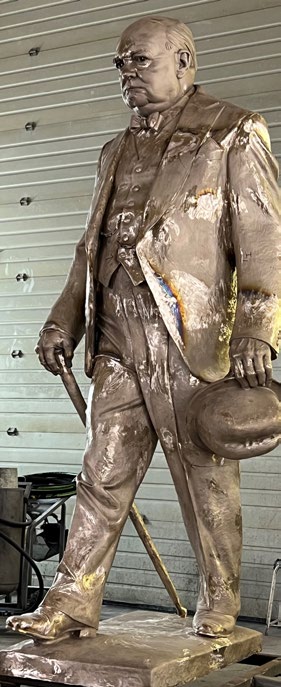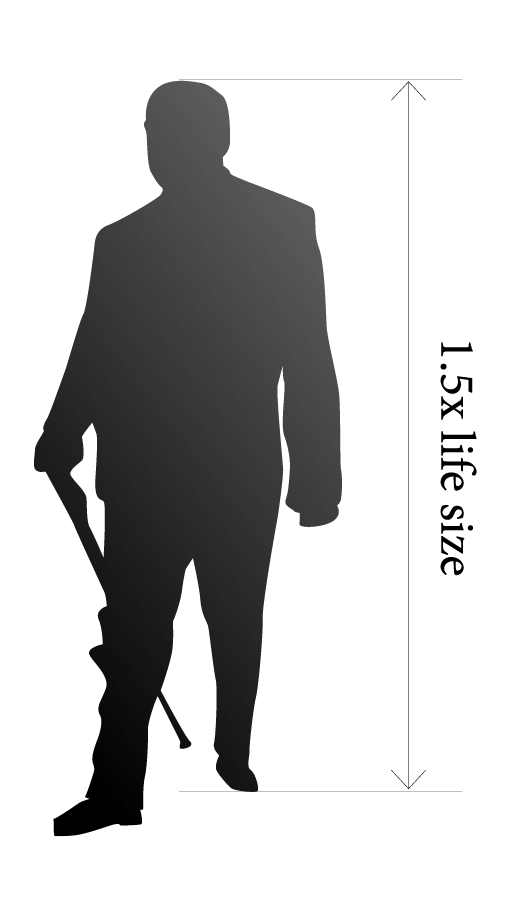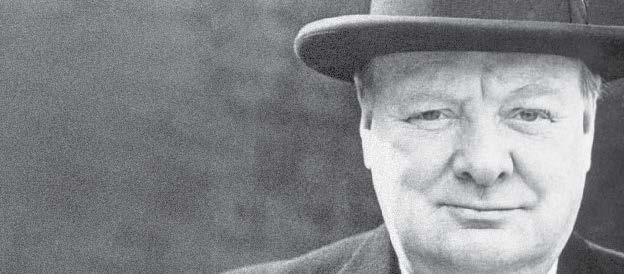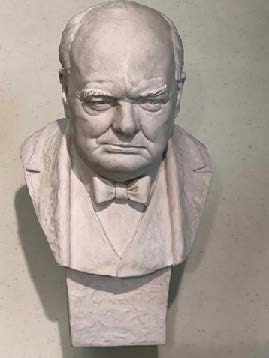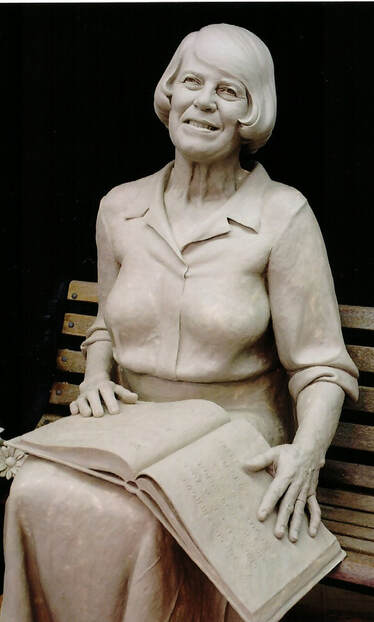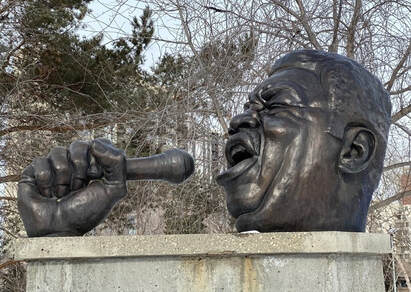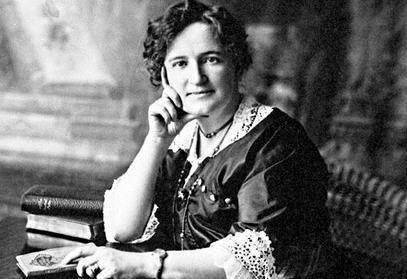THE CHURCHILL STATUE PROJECT
|
WHY IT'S IMPORTANT
Sir Winston Churchill was one of the greatest political leaders of the twentieth century. The Sir Winston Churchill Society of Calgary wishes to keep his legacy alive with a statue and in commemoration of his 1929 visit to Alberta. We wish to:
Edmonton sculptor Danek Mozdzenski has created the statue of Sir Winston Churchill and his previous work includes sculptures of the late Alberta Lieutenant Governor Lois Hole; the jazz musician and blues singer, Clarence Horatio Miller; Alberta suffragist Nellie McClung, Brock University’s $1.2 million monument to Sir Isaac Brock, and the Lester B. Pearson monument on Parliament Hill. |
RELEVANCY TO CANADA AND ALBERTA
In 1929, Churchill visited Alberta. His tour included the Turner Valley oil fields, the Prince of Wales ranch, Calgary and the Canadian Rockies, where Churchill created several paintings. While in Calgary, Churchill gave a speech at the Palliser Hotel, and was given an off-white Stetson hat, a hat that he would keep for his entire life and often wear while painting. At Lake Louise, Churchill described it as a “truly enchanting scene”. Churchill said that in any of his travels over four continents, the comfort and beauty of Lake Louise had “never been surpassed”.
In 1929, Churchill visited Alberta. His tour included the Turner Valley oil fields, the Prince of Wales ranch, Calgary and the Canadian Rockies, where Churchill created several paintings. While in Calgary, Churchill gave a speech at the Palliser Hotel, and was given an off-white Stetson hat, a hat that he would keep for his entire life and often wear while painting. At Lake Louise, Churchill described it as a “truly enchanting scene”. Churchill said that in any of his travels over four continents, the comfort and beauty of Lake Louise had “never been surpassed”.
|
LOCATION McDougall Centre is situated in the core of Calgary in an historic building that first served as a school. With grounds open to the public, it is an ideal location for the statue as visitors to the grounds will be able to view this new work of art along with another existing memorial to the Second World War - the Airmen’s statue. Located on the south lawn, the statue will face southwest to symbolize Churchill’s love for both the vistas of southern Alberta and to the west, the Canadian Rockies. |
|
“My great-grandfather loved your country. He recorded the beauty of Alberta in his paintings during his 1929 visit, and spoke warmly of its grandeur. In September 1941, speaking in London at a dinner to honour Mackenzie King, Prime Minister of Canada, he memorably said: ‘Canada is the linchpin of the English-speaking world.’
On behalf of the Churchill family, we are grateful to you all for continuing to keep alive the memory of Churchill and for supporting our shared and hard-won legacy of freedom.” — With my very best, RANDOLPH CHURCHILL III |
When Churchill arrived in Calgary on a Saturday morning, August 24, 1929, he walked across the CPR train station platform and gazed westward at the Rockies and remarked that “What a glorious day! I can just see the peaks of the Rockies from here!”
According to Bradley Tolpannen in his book, Churchill in North America, 1929, Churchill was fascinated by southern Alberta. At the Turner Valley oil fields, he would write to his wife, Clementine, that they were “amazing” and speculated he might buy 1,000 shares in Alberta-based oil firms.
The Sir Winston Churchill Society of Calgary is a registered charitable society, founded in 1966 by the then-publisher of the Calgary Herald, Frank Swanson, a former war correspondent, and Vera Swanson, whom the journalist me in in Great Britain during the Second World War.
The Society is the sponsor of the annual Sir Winston Churchill High School debates, and awards annual bursaries to winners of the Mount Royal University Moot Court debates, and to promising student painters at Alberta University of the Arts.
According to Bradley Tolpannen in his book, Churchill in North America, 1929, Churchill was fascinated by southern Alberta. At the Turner Valley oil fields, he would write to his wife, Clementine, that they were “amazing” and speculated he might buy 1,000 shares in Alberta-based oil firms.
The Sir Winston Churchill Society of Calgary is a registered charitable society, founded in 1966 by the then-publisher of the Calgary Herald, Frank Swanson, a former war correspondent, and Vera Swanson, whom the journalist me in in Great Britain during the Second World War.
The Society is the sponsor of the annual Sir Winston Churchill High School debates, and awards annual bursaries to winners of the Mount Royal University Moot Court debates, and to promising student painters at Alberta University of the Arts.
|
“The only place that Churchill ever spoke of retiring to – part from his home in Kent - was Alberta, such was his love of the province and its sense of boundless possibilities. It is fitting that the greatest champion of liberty of the 20th century should be commemorated in such a magnificent way in Calgary. Observed in his proper historical context, we see a man who insisted on the equality of all races before the law throughout the Empire throughout his career, who put his life on the line many times to defend the indigenous populations of the Empire, and who defeated and destroyed history’s worst racist, Adolf Hitler. Churchill adored Canada, and it is wonderful to see Canadians return the tribute.”
— ANDREW ROBERTS, author: ‘Churchill: Walking with Destiny’ |
THE SOCIETY'S MISSION STATEMENT
The Sir Winston Churchill Society promotes students’ facility in the use of the spoken and written word emphasizing oratorical and communication skills as exemplified by the debates, speeches and writings of Sir Winston Spencer- Churchill. The Society also exists to preserve and promote the legacy of Sir Winston Spencer-Churchill, including his achievements in the face of tyranny and the preservation of freedom, and in so doing commemorate his leadership and achievements.
The Sir Winston Churchill Society promotes students’ facility in the use of the spoken and written word emphasizing oratorical and communication skills as exemplified by the debates, speeches and writings of Sir Winston Spencer- Churchill. The Society also exists to preserve and promote the legacy of Sir Winston Spencer-Churchill, including his achievements in the face of tyranny and the preservation of freedom, and in so doing commemorate his leadership and achievements.
|
THE ASK
What we accomplished so far The Sir Winston Churchill Society of Calgary has raised $300,000 for the design and sculpting of the finished bronzed statue including payments to the sculptor. We now seek $150,000 for:
|
DONATE
The Sir Winston Churchill Society of Calgary is a registered charity and is seeking only donor (and not taxpayer) funds for this Churchill legacy project. We welcome donations in any amount. All donations will receive a charitable receipt and all donors will automatically be enrolled as members of the Society.
If you wish to donate to the Churchill Leadership Initiative and Statue Project:
The Sir Winston Churchill Society of Calgary is a registered charity and is seeking only donor (and not taxpayer) funds for this Churchill legacy project. We welcome donations in any amount. All donations will receive a charitable receipt and all donors will automatically be enrolled as members of the Society.
If you wish to donate to the Churchill Leadership Initiative and Statue Project:
- Click on the 'Donate' button below
- Fill out the form below and send by mail.
- Or mail a cheque directly to
The Sir Winston Churchill Society of Calgary
287 Discovery Ridge Way S.W.
Calgary, AB T3H 5S8
|
| ||||||||||||
|
DONATION LEVELS
For those who donate $2,500 or more, donors will also receive either a framed, artist-signed picture of the statue (for donations between $2,500 and to $4,999), or a Churchill bust replicated from the actual statue itself, that is progressively larger with each donation level: The Churchill bust, cast in bronze, is an original creation by the Churchill statue sculptor, Danek Mozdzenski. The bust will be gifted to significant donors at the following levels:
|
Why the Sir Winston Churchill Leadership Initiative and Statue Project?
About the sculptor
Danek Mozdzenski has been commissioned to create the statue of Sir Winston Churchill. Danek is an Edmonton-born, self-educated sculptor and painter. Danek unveiled his first public commission – a bust of renowned author Joseph Conrad – in 1967, at the age of 14, as part of the Edmonton Centennial Library’s (now known as the Stanley A. Milner Library) artistic celebration of Canada’s 100 years of statehood.
His commissioned work is housed in public and private collections in Canada, the United States, England, Poland, Denmark and Saudi Arabia. They include sculptures of the late Alberta Lieutenant Governor Lois Hole; the jazz musician and blues singer, Clarence Horatio Miller; and Alberta suffragist Nellie McClung.
Two major works are Brock University’s $1.2 million monument to Sir Isaac Brock, unveiled in 2015, and the Lester B. Pearson monument on Parliament Hill in Ottawa, unveiled in 1988. The Pearson monument is of the same scale as our intended 1.5 times life size striding image of Sir Winston Churchill.
Danek Mozdzenski has been commissioned to create the statue of Sir Winston Churchill. Danek is an Edmonton-born, self-educated sculptor and painter. Danek unveiled his first public commission – a bust of renowned author Joseph Conrad – in 1967, at the age of 14, as part of the Edmonton Centennial Library’s (now known as the Stanley A. Milner Library) artistic celebration of Canada’s 100 years of statehood.
His commissioned work is housed in public and private collections in Canada, the United States, England, Poland, Denmark and Saudi Arabia. They include sculptures of the late Alberta Lieutenant Governor Lois Hole; the jazz musician and blues singer, Clarence Horatio Miller; and Alberta suffragist Nellie McClung.
Two major works are Brock University’s $1.2 million monument to Sir Isaac Brock, unveiled in 2015, and the Lester B. Pearson monument on Parliament Hill in Ottawa, unveiled in 1988. The Pearson monument is of the same scale as our intended 1.5 times life size striding image of Sir Winston Churchill.
